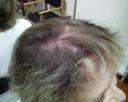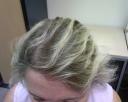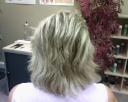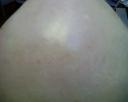Why children who braid it like Beckham risk losing hair.
30.10.2007 in UncategorizedFrom
August 24, 2007
Why children who braid it like Beckham risk losing hair

Girls who plait their hair too tightly or scrape it back in braids or a ponytail may be at risk of permanent hair loss, researchers suggest.
Hairstyles such as corn rows or braids and those that require chemical straighteners, weaves or hair extensions can damage hair and cause bald patches over time, the British Journal of Dermatology reports today.
Related diseases of the scalp, skin and hair are thought to affect people of African descent particularly. However, dermatologists have underlined the dangers of excessive treatment or scraping back for any hair type.
The tight bun styles favoured by ballet dancers, the corn rows once sported by David Beckham or the dramatic “Croydon facelift” look parodied by Vicky Pollard, the Little Britain character, could all potentially cause problems, they said.
A study of nearly 2,000 adults and children in South Africa found that one in seven schoolgirls and a third of women were suffering from “traction alopecia”, hair loss thought to be caused by excessive and prolonged pulling of the hair.
One in ten African men was found to have a skin disorder known as “acne keloidalis nuchae”, which can cause pimples, scarring and hair loss at the back of the head.
The researchers, from the University of Cape Town, linked the condition to the frequent close-shave haircuts that are popular among black men, but said that they could also increase the risk of blood-borne infections.
Hair loss was found to be more common in children whose hair had been chemically “relaxed” or straightened to form a ponytail. One in five children with relaxed hair had traction alopecia, against just one in twenty of those with natural hair.
In adults, hair loss was found to be more likely among women with either “relaxed” hair or braided natural hair, as against natural hair without braids; and it was most common when the hair was relaxed and also had extensions (such as braids or weaves) attached. “This suggests that relaxed hair may be weakened and less resistant to traction, such as is caused by attaching extensions to the hair,” the researchers write.
Men’s haircuts were found to be shorter, more frequent and more likely to cause accidental cuts and bleeding, which could lead to skin problems or infections, the researchers said.
One of the authors, Dr Nonhlanhla Khumalo said: “Traction alopecia is common in women and girls, particularly when relaxed hair has braids, extensions or weaves attached. This can cause unsightly hair loss.
“AKN [acne keloidalis nuchae] appears more common in men who frequently cut their hair, and is linked to haircut-associated symptoms, such as pimples, crusts and bleeding. To achieve the shortest possible haircut, electric shavers are often dug into the scalp. The possible risk for blood-borne disease transmission, such as viral hepatitis and HIV, associated with such haircuts needs to be quantified and nonmechanical methods of cutting hair may be safer.”
The study found that a further 7 per cent of women aged over 50 years had central centrifugal cicatricial alopecia – permanent hair loss that spreads from the centre of the scalp. While hair relaxers are thought to play a part in this, the exact cause is unknown.
Andrew McDonagh, a consultant dermatologist at the Royal Hallamshire Hospital in Sheffield, said yesterday that the findings confirmed previous anecdotal evidence that traction alopecia could be caused by particular hair styles.
“We see a number of black patients with traction alopecia each year and it’s recognised to be a major problem, especially in the US where there is a large black population,” he said. “But you see other patients with the condition, who may have treated their hair or worn it pulled back from the scalp.”
Do you have Hair Loss Problems, read our Hair Loss Help











